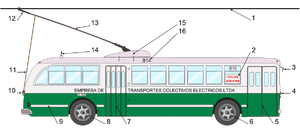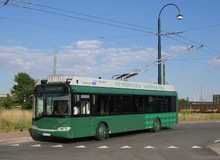
Solaris trolleybus in Landskrona, Sweden
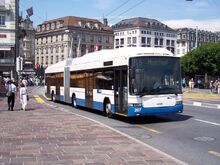
Hess-built trolleybus in Lucerne, Switzerland

Trolleybus in Athens,Greece
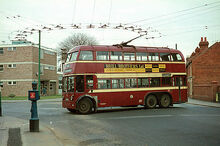
A double-deck trolleybus in Reading, England, 1966
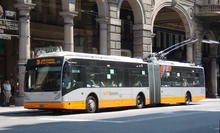
Van Hool trolleybus in Genoa, Italy
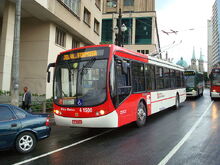
Busscar trolleybus in São Paulo, Brazil
A trolleybus (also known as trolley bus, trolley coach, trackless trolley, trackless tram or trolley) is an electric bus that draws its electricity from overhead wires (generally suspended from roadside posts) using spring-loaded trolley poles. Two wires and poles are required to complete the electrical circuit, unlike a tram or streetcar, which normally uses the track as part of the electrical path and thus needs only one wire and pole.
Background[]
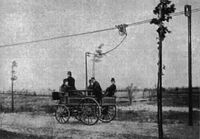
The "Elektromote", the world's first trolleybus, in Berlin, Germany, 1882
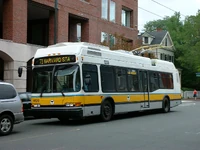
A new MBTA trolleybus near Harvard Square, Cambridge, USA. The "offside" door (on the left-hand side of the bus, despite the right-hand traffic) is particular to buses using the Harvard Square station in Cambridge

Changjiang-Flxible CJWG110K trolleybus No.156 on the rainy streets of Hangzhou, China
The history of the trolleybus dates back to 29 April 1882, when Dr. Ernst Werner von Siemens ran his "Elektromote" in a Berlin suburb. This experimental demonstration continued until 13 June 1882, after which there was little progress in Europe, although separate experiments were conducted in the USA. The next development was when Lombard Gérin operated an experimental line at the Paris Exhibition of 1900 after four years of trials. Max Schiemann made the biggest step when on 10 July 1901 the world's first passenger-carrying trolleybus operated at Bielathal (near Dresden), in Germany. Schiemann built and operated the Bielathal system, and is credited with developing the under-running trolley current collection system, with two horizontally parallel overhead wires and rigid trolleypoles spring-loaded to hold them up to the wires. Although the Bielathal system operated only until 1904, Schiemann had developed what is now the standard trolleybus current collection system. In the early days there were a few different methods of current collection. The Cedes-Stoll system, designed by Carl Stoll, operated near Dresden between 1902 and 1904, and in Vienna. The Lloyd-Köhler or Bremen system was tried out in Bremen, and the Filovia was demonstrated near Milan.
Leeds and Bradford became the first cities to operate trolleybuses in the United Kingdom on 20 June 1911. Bradford was the last to operate trolleybuses in the UK, the system closing on 26 March 1972. The last rear-entrance trolleybus in Britain was also in Bradford and is now owned by the Bradford Trolleybus Association. Birmingham was the first to replace a tram route with trolleybuses, while Wolverhampton under the direction of Charles Owen Silvers turned the "trackless tram" into the trolleybus. There were 50 trolleybus systems in the UK, London's being the largest. By the time trolleybuses arrived in Britain in 1911, the Schiemann system was well-established and was the most common, although the short-lived Stockport operation used the Lloyd-Kölher system and Keighley used the Cedes-Stoll system.
In the United States, some cities, led by the Brooklyn-Manhattan Transit Corporation (BMT—New York), subscribed to the all-four concept of using buses, trolleybuses, trams (in US called streetcars or trolleys) and rapid transit subway and/or elevated lines (metros), as appropriate, for routes ranging from lightly-used to the heaviest trunk line. Buses and trolleybuses in particular were seen as entry systems that could later be upgraded to rail as appropriate. Although the BMT in Brooklyn built only one trolleybus line, other cities, notably San Francisco, California and Philadelphia, Pennsylvania, built larger systems and still maintain "all-four".
A number of trolleybus lines in the United States came into existence when a tracked trolley/tram route did not have sufficient ridership to warrant track maintenance or reconstruction. In a similar manner, a proposed tram scheme in Leeds, United Kingdom, was changed to a trolleybus scheme to cut costs.[1]
Trolleybuses are uncommon today in North America, but they remain common in many European countries, and in Russia and China, generally occupying the niche between street railways (trams) and diesel buses. Worldwide, around 340 cities or metropolitan areas are served by trolleybuses today.[2] (Further detail under Use and preservation, below.)
Design[]
Advantages[]
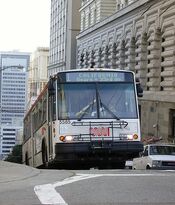
A San Francisco Muni trolleybus climbing Nob Hill
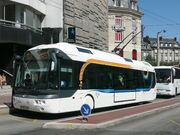
Irisbus Cristalis trolleybus in Limoges, France
Trolleybuses are advantageous on hilly routes, as electric motors are more effective than diesel engines for climbing steep hills. Unlike combustion engines, electric motors draw power from a central plant and can be overloaded for several minutes without damage. San Francisco and Seattle, both hilly United States cities, use trolleybuses partly for this reason, another being improved air quality. Given this acceleration and braking performance, trolleybuses easily outperform diesel buses on flat stretches as well.
Trolleybuses' rubber tires have better adhesion than trams' steel wheels on steel rails, giving them better hill-climbing capability and braking. Unlike rail vehicles (where side tracks are not available), an out-of-service vehicle can be moved to the side of the road and its trolley poles disconnected, allowing other vehicles to pass. Additionally, because they are not tracked, trolleybuses can pull over to the curb as a diesel bus does, eliminating boarding islands in the street.
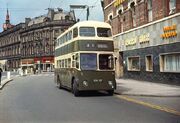
A Derby Corporation trolleybus in Victoria Street, 30 July 1967. The system closed on 9 September 1967, and this vehicle is preserved in running order at the Black Country Living Museum.
Like other electric vehicles, trolleybuses are more environmentally friendly than fossil-fuel or hydrocarbon-based vehicles (petrol/gasoline, diesel, alcohol, etc.). However the power is not free, having to be produced at centralised power plants, with attendant transmission losses.
On the other hand, centrally-produced power is produced more efficiently, not bound to a specific fuel source and more amenable to pollution control as a single-source supply than are individual vehicles with their own engines that exhaust noxious gases and particulates at street level. Moreover, some cities, like Calgary, Alberta, run their light rail networks using wind energy,[3] which is effectively emission-free once the turbines are built and installed. Other cities like Vancouver, B.C. use hydroelectricity to provide power for trolley buses. A further advantage of trolleybuses is that they can generate electricity from kinetic energy while braking, a process known as regenerative braking.
Unlike buses or trams, trolleybuses are almost silent, lacking the noise of a diesel engine or wheels on rails. Such noise as there is tends to emanate from auxiliary systems such as power steering pumps and air conditioning. Early trolleybuses without these systems were even quieter, and in the UK at least were often referred to as the "Silent Service". The quietness did have its disadvantages though, with quite a number of pedestrians falling victim to what was also known as "the Silent Death".
Trolleybuses are specially favoured where electricity is abundant and cheap. Examples are the extensive systems in Vancouver, Canada and Seattle, USA, both of which draw hydroelectric power from the Columbia River and other Pacific river systems. Seattle benefits doubly, with steep gradients near the Downtown waterfront and on Queen Anne, First, and Capitol Hills. San Francisco operates its system using hydro power from the city-owned Hetch Hetchy generating plant.
Trolleybuses are used extensively in large European cities such as Athens, Belgrade, Bratislava, Bucharest, Budapest, Kiev, Lyon, Milan, Minsk, Moscow, Naples, Riga, Saint Petersburg and Sofia, as well as smaller ones such as Arnhem, Bergen, Brasov, Brest (Belarus), Coimbra, Gdynia, Lausanne, Limoges, Luzern, Parma, Piatra Neamţ, Plzeň, Prešov, Salzburg, Solingen, Szeged, Tallinn and Yalta.
Realising the advantages of these zero-emission vehicles, some other European cities have started to expand their systems again. Other cities such as Lecce will introduce new trolleybus systems.
In Cambridge, Massachusetts, the trolleybus system has survived because Harvard Station has a tunnel that was once used for trams that requires left-side doors and has fume concerns. Buses also use the tunnel, but the trolleybuses remain due to popular support.
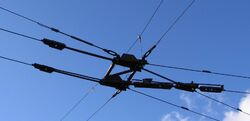
Trolleybus wire switch
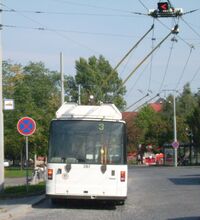
Indicator for a wire switch[4]
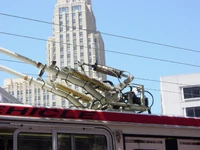
Pole headworks with springs and dampers
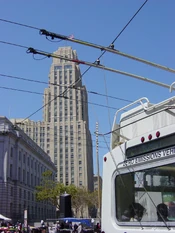
Insulated poles, contactors, and pull–ropes
Disadvantages[]
Re-routings, temporary or permanent, are not usually readily available outside of "downtown" areas where the buses may be re-routed via adjacent business area streets where other trolleybus routes operate. This problem was highlighted in Vancouver in early 2008 when an explosion closed Broadway, a heavily-used trolley route. Because of the closure, trolleys were forced to detour several kilometers off their route in order to stay on the wires, leaving major portions of their routes unserved and trolleys well off schedule.
Some trolleybus systems have been criticised for aesthetic reasons, with city residents complaining that the jumble of overhead wires was unsightly.[5] Intersections often have a "webbed ceiling" appearance, due to multiple crossing and converging sets of line wires.
Dewirements sometimes occur, leaving the bus stranded without power, although this is relatively rare on systems with well-maintained overhead wire, hangers, fittings and "contact shoes".
Trolleybuses cannot overtake one another in regular service unless two separate sets of wires with a switch are provided or the vehicles are equipped with off-wire capability, but the latter is an increasingly common feature of new trolleybuses.
Recent power developments[]
With the introduction of hybrid designs, trolleybuses are no longer tied to overhead wires. Since the 1980s, trolleybus systems such as Muni in San Francisco, TransLink in Vancouver and Beijing, among others, have purchased trolleybuses equipped with batteries to allow the vehicles to operate short to considerably long distances away from the wires. Supercapacitors may be also used to move short distances.
Trolleybuses can optionally be equipped either with limited off-wire capability—a small diesel engine or battery pack—for auxiliary or emergency use only, or full dual-mode capability. A simple auxiliary power unit can allow a trolleybus to get around a route blockage or can reduce the amount (or complexity) of overhead wiring needed at operating garages (depots). This capability has become increasingly common in newer trolleybuses, particularly in North America and Western Europe, where the vast majority of new trolleybuses delivered since the 1990s are fitted with at least limited off-wire capability. These have gradually replaced older trolleybuses which lacked such capability. In Philadelphia, new trolleybuses (known as "trackless trolleys" there) that were placed in service by SEPTA in 2008 are equipped with small hybrid diesel-electric power units for operating short distances off-wire, instead of using a conventional diesel drive train or battery-only system for their off-wire movement.[6]
King County Metro in Seattle, Washington and MBTA in Boston use or have used dual-mode buses that run on electric power from overhead wires on a fixed right-of-way and on diesel power on city streets. Metro used special-order articulated Breda buses with the center axle driven electrically and the rear (third) axle driven using a conventional power pack, with electricity used for clean operation in the downtown transit tunnel. They were introduced in 1990 and retired in 2005, replaced with cleaner hybrid buses, although 59 of 236 had their diesel propulsion equipment removed and continue (as of 2010) in trolley bus service on non-tunnel routes. MBTA uses dual-mode buses on its new (2004-opened) Silver Line (Waterfront).
Other considerations[]
With increasing diesel fuel costs and particulate matter and NOx emissions problems in many cities, trolleybuses may be seen as the best option, either as the primary transit mode or as a supplement to rapid transit and commuter rail networks.
Some have suggested that the trolleybus will become obsolete in a future hydrogen economy, but direct electric transmission is far more efficient (by a factor of two or more) than conversion of energy into hydrogen, transportation and storage of the hydrogen and its conversion back into electricity by fuel cells.
As trolleybuses are electric, they produce very little noise compared with a diesel- or petrol-engined vehicle. While this is mainly seen as a benefit, it does also make it is easier for unobservant pedestrians and other motorists to miss hearing a trolleybus when crossing a street, and risk being struck. For this reason, in Australia trolleybuses were sometimes known as "whispering death".
Trolleybuses can share overhead wires and other electrical infrastructure (such as substations) with tramways. This can result in cost savings when trolleybuses are added to a transport system that already has trams, though this refers only to potential savings over the cost of installing and operating trolleybuses alone.
Trolleybus wire switch[]
Trolleybus wire switches (referred to as "frogs" in some countries) are used where a trolleybus line branches into two. A switch may be either in a "straight through" or "turnout" position; it normally remains in the "straight through" position unless it has been triggered, and reverts to it after a few seconds. Triggering is often caused by a pair of contacts or electromagnets, with one attached to each trolleybus wire, close to but before the switch itself.
Multiple branches may be handled by installing more than one switch. For example, to provide straight-through, left-turn or right-turn branches at an intersection, one switch is installed some distance from the intersection to choose a line over the left-turn lane, and another switch is mounted close to the intersection to choose between straight through and a right turn.[7] (This would be the arrangement in countries such as the US, where traffic directionality is right-handed; in left-handed traffic countries such as Britain and New Zealand, the switch some distance from the intersection would be used to access the right-turn lanes, and the switch close to the intersection would be for the left-turn fork instead.)
Three common types of switch[7] exist: Power-on/Power-off (the picture of a switch above is of this type), Selectric, and Fahslabend.
A Power-on/Power-off switch is triggered if the trolleybus is drawing power from the overhead wires, usually by accelerating, when the poles pass over the contacts. (The contacts are lined up on the wires in this case.) If the trolleybus "coasts" through the switch it will not activate. Some trolleybuses, such as those in Philadelphia, have a "power-coast" toggle switch that turns the power on or off. This allows a switch to be triggered in situations that would otherwise be impossible, such as activating a switch while braking or accelerating through a switch without activating it.
A Selectric switch has a similar design, but the contacts on the wires are skewed, often at a 45-degree angle, rather than being lined up. This skew means that a bus going straight through will not trigger the switch, but a trolleybus attempting a sharp turn (usually a right turn in countries with right-handed traffic) will cause its poles to meet the wires in a matching skew with one pole ahead of the other, which will trigger the switch.
For a Fahslabend switch, the trolleybus's turn indicator (or a separate driver-controlled switch) causes a coded radio signal to be sent from a transmitter, often attached to a trolley pole. The receiver is attached to the switch, and causes it to trigger if the correct code is received. This has the advantage that the driver does not need to be accelerating the bus (as with a Power-on/Power-off switch) or trying to make a sharp turn (as with a Selectric switch).
Trolleybus makers[]
- This list is incomplete; you can help by expanding it.
Current[]
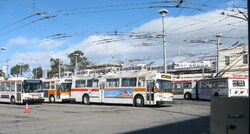
Trolleybus garage (depot) in San Francisco, USA, with a range of Muni's trolleybuses dating from 1976 to 2003. On the left is an ETI (Skoda/AAI) 14TrSF trolleybus, which type replaced the non-accessible Flyer trolleybuses in the center. On the right is an articulated New Flyer trolleybus, one of 60 articulated ETBs built by New Flyer for Muni in 1993-94
- Astra Bus (Romania)
- Belkommunmash
- Berkhof
- Bogdan Corporation
- Bashkir Trolleybus Plant (BTZ)Ufa
- Busscar (Brazil)
- Carrosserie Hess
- Designline - for the trolleybuses to replace Wellington, New Zealand's fleet
- Electrotrans-Service
- Eletra Industrial Ltda (Brazil)
- Fiat Group
- Iveco
- Irisbus (with electrical equipment by Škoda Works)
- Iveco
- Jelcz
- LiAZ
- Lviv Bus Factory
- Mercedes-Benz
- MAZ
- Neoplan
- New Flyer Industries
- PTMZ
- Škoda Works
- Solaris Bus & Coach (with electrical equipment by Ganz (owned by Škoda Works) and DP Ostrava)
- Sor
- Sunwin
- TransAlfa
- Trolza, major producer in Russia
- Trobus
- Van Hool
- Volvo
- Volgograd transport & mashinery plant
- YuMZ - Dnipropetrovsk, Ukraine
- Youngman
Defunct or no longer making trolleybuses[]
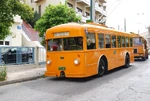
Preserved vintage trolleybus made by FIAT for the Piraeus-Kastella line in Greece (1939)
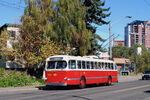
- Alfa Romeo, Italy
- AM General, USA
- AnsaldoBreda (and predecessors Ansaldo Trasporti and Breda Costruzioni Ferroviarie), Italy
- Antonov Aircraft Factory, Kiev, Ukraine
- Associated Equipment Company, UK
- British United Traction, UK
- Chavdar, Bulgaria
- Crossley Motors, UK
- Daimler Motor Company, UK
- Dennis Specialist Vehicles, UK
- Electric Transit, Inc., USA-based joint venture
- Fiat (subsidiary Irisbus is still manufacturing trolleybuses), Italy
- FBW, Switzerland
- Gräf & Stift, Austria
- Guy Motors, UK
- Henschel. Germany
- Hispano-Suiza, Spain
- Ikarus, Hungary
- J.G. Brill, USA
- Lancia, Italy
- Leyland Motors, UK
- Marmon-Herrington, USA
- MASA (Mexicana de Autobuses SA) - now part of Volvo, Mexico
- NAW, Switzerland
- Neoplan USA
- Pegaso, Spain
- Praga, CZ
- Pullman Standard, USA
- Richard Garrett & Sons, UK
- Rocar, Romania
- Saurer, Switzerland
- St. Louis Car Company, USA
- Sunbeam, UK
- Tatra, CZ
- Tushino Mechanical Plant, Russia
- Twin Coach, USA
- Vetra, France
- Yaroslavl motor plant, Russia
List of Low-floor trolleybuses[]
- Belkommunmash: AKSM 221, AKSM 321, AKSM 420
- Busscar: Urbanuss Pluss
- Carrosserie Hess
- Eurotrolley 3
- Swisstrolley 3
- lighTram 3
- Designline
- Ikarus: 411T, 412T, 435T
- Irisbus: Civis, Cristalis
- Lviv Bus Factory
- ElektroLAZ-183 ru:Изображение:ElektroLAZ in Ternopil.jpg
- MAN/Kiepe NG
- MAZ: 103T, 203T
- Neoplan
- N6014/6108/6110/6114/6121
- Electroliner: N6216/N6221/N6321
- New Flyer Industries: E40LFR, E60LFR
- Solaris
- Trollino: 12, 15, 18
- Škoda: 21Tr, 22Tr, 24Tr, 25Tr, 26Tr, 27Tr, 28Tr
- TrolZa: Megapolis
- Van Hool: A330T, AG300T
- Jelcz
Double-decker trolleybuses[]
Since the end of 1997, no double-decker trolleybuses have been in service anywhere in the world, but in the past several manufacturers made such vehicles. Most builders of double-deck trolleybuses were in the United Kingdom, but there were a few, usually solitary, instances of such trolleybuses being built in other countries, including in Germany by Henschel (for Hamburg); in Italy by Lancia (for Porto, Portugal); in Russia by the Yaroslavl motor plant (for Moscow) and in Spain by Maquitrans (for Barcelona).[8] British manufacturers of double-deck trolleybuses included AEC, BUT, Crossley, Guy, Leyland, Karrier, Sunbeam and others.[8]
In 2001, Citybus (Hong Kong) converted a Dennis Dragon (#701) into a double-decker trolleybus,[9] and it was tested on a 300-metre track in Wong Chuk Hang in that year.[9] Hong Kong decided not to build a trolleybus system, and the testing of this prototype did not lead to any further production of vehicles.
Use and preservation[]
There are currently around 340 cities or metropolitan areas where trolleybuses are operated,[2] and almost 500 additional trolleybus systems have existed in the past.[8] For complete lists of trolleybus systems by location, with dates of opening and (where applicable) closure, see List of Trolleybus systems and the related lists indexed there.
The summary notes about current and past trolleybus operation in some countries, have been moved to the list of Trolleybus systems.
See also[]
- Bombardier Guided Light Transit
- Electric bus
- Gyrobus
- List of trolleybus systems
- Low-floor trolleybuses
- Specialist bus chassis builders
- Tourist trolley
- Translohr
- Trolleytruck
- Glossary Index
| |||||||||||||||||
| ||||||||||||||
| ||||||||||||||
References / sources[]
- ↑ "Plan for city trolleybus comeback". BBC News (15 June 2007). Retrieved on 2009-06-03.
- ↑ 2.0 2.1 Webb, Mary (ed.) (2008), Jane's Urban Transport Systems 2008-2009. Coulsdon, Surrey (UK): Jane's Information Group. ISBN 978-0-7106-2860-2.
- ↑ Wind Energy Background
- ↑ Greenfleet
- ↑ Overhead
- ↑ Trolleybus Magazine No. 267 (May-June 2006), p. 71. National Trolleybus Assn. (UK).
- ↑ 7.0 7.1 Electric Vehicle Technologies. Transport 2000 BC. Archived from the original on 2006-03-03.
- ↑ 8.0 8.1 8.2 Murray, Alan (2000). World Trolleybus Encyclopaedia. Yateley, Hampshire, UK: Trolleybooks. ISBN 0-904235-18-1.
- ↑ 9.0 9.1 Trolleybus Magazine No. 238 (July-August 2001), pp. 73 and 88.
Books[]
- Sebree, Mac; and Ward, Paul (1973). Transit’s Stepchild, The Trolley Coach (Interurbans Special 58). Los Angeles: Interurbans. LCCN 73-84356
- Sebree, Mac; and Ward, Paul (1974). The Trolley Coach in North America (Interurbans Special 59). Los Angeles: Interurbans. LCCN 74-20367
- Porter, Harry; and Worris, Stanley F.X. (1979). Trolleybus Bulletin No. 109: Databook II. North American Trackless Trolley Association (defunct)
- Murray, Alan (2000). World Trolleybus Encyclopaedia. Trolleybooks (UK). ISBN 0-904235-18-1
- Mick Leak (2006). The Story Of Britain's Last Rear Entrance Trolleybus In Public Service - Bradford 758. Published By The Bradford Trolleybus Association. Bradford. United Kingdom
Periodicals[]
- Trolleybus Magazine (ISSN 0266-7452). National Trolleybus Association (UK), bi-monthly
- Trackless, Bradford Trolleybus Association, quarterly
- Trolleybus, British Trolleybus Society (UK), monthly
Other sources[]
- North American trolleybus pictures
- All-time list of North American trolleybus systems, accessed 30 January 2004
- British trolleybuses
- Trolleybuses at the BCLM
- Trolleybuses in Latin America
External links[]
- Adopting the Technology to the Future
- Bradford Trolleybus Association
- Trolleymotion - an international action group to promote modern trolleybus systems (+ database of systems in the world)
- History of Valparaíso's trolleybus service
- Bibliography of the electric trolleybus (Richard DeArmond)
- British trolleybuses
- Trolleybuses in Europe
- Transit World - Features photos of Trolleybuses in Vancouver & Edmonton (Canada), Wellington (New Zealand), Geneva (Switzerland), Rome (Italy) and Seattle (USA)
- MOTAT MOTAT Trolley Bus collection. Auckland (New Zealand).
- Tom's North American Trolleybus Pictures
- Trolleybus & trams from Belgium & other countries
- Yahoo! trolleycoach group
- TRANSIRA Association (Romania)
- Estonian Trolley History
| |||||||||||||||||||||||||||||||||||||||||||||||||||||||||||||||||||||||||
| This page uses some content from Wikipedia. The original article was at Trolleybus. The list of authors can be seen in the page history. As with Tractor & Construction Plant Wiki, the text of Wikipedia is available under the Creative Commons by Attribution License and/or GNU Free Documentation License. Please check page history for when the original article was copied to Wikia |
